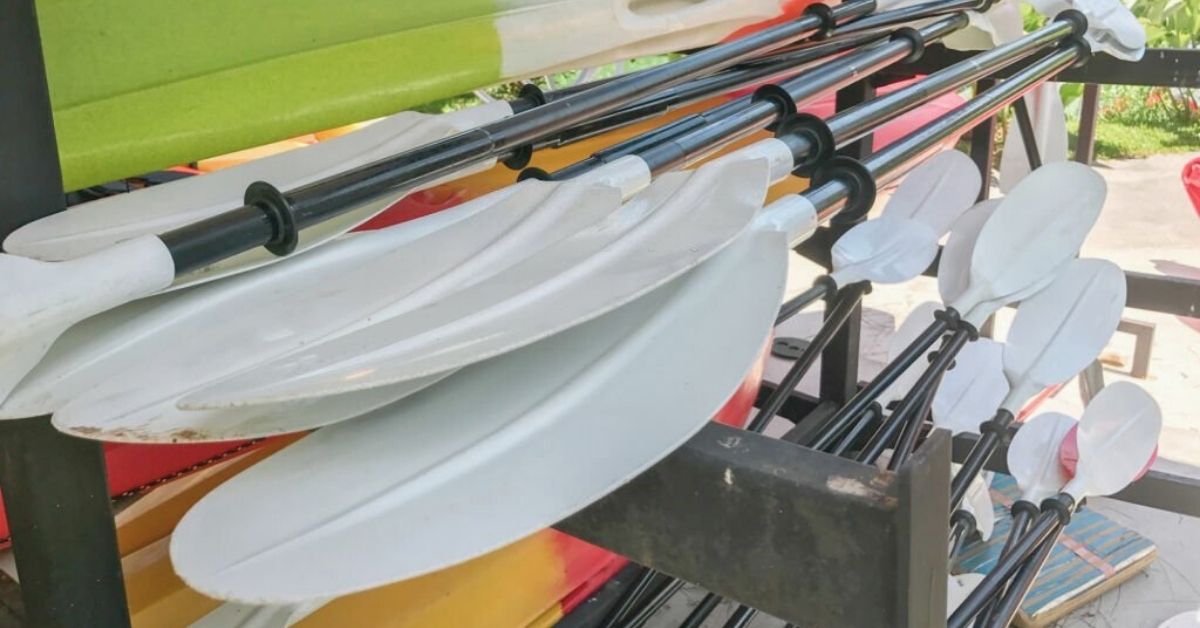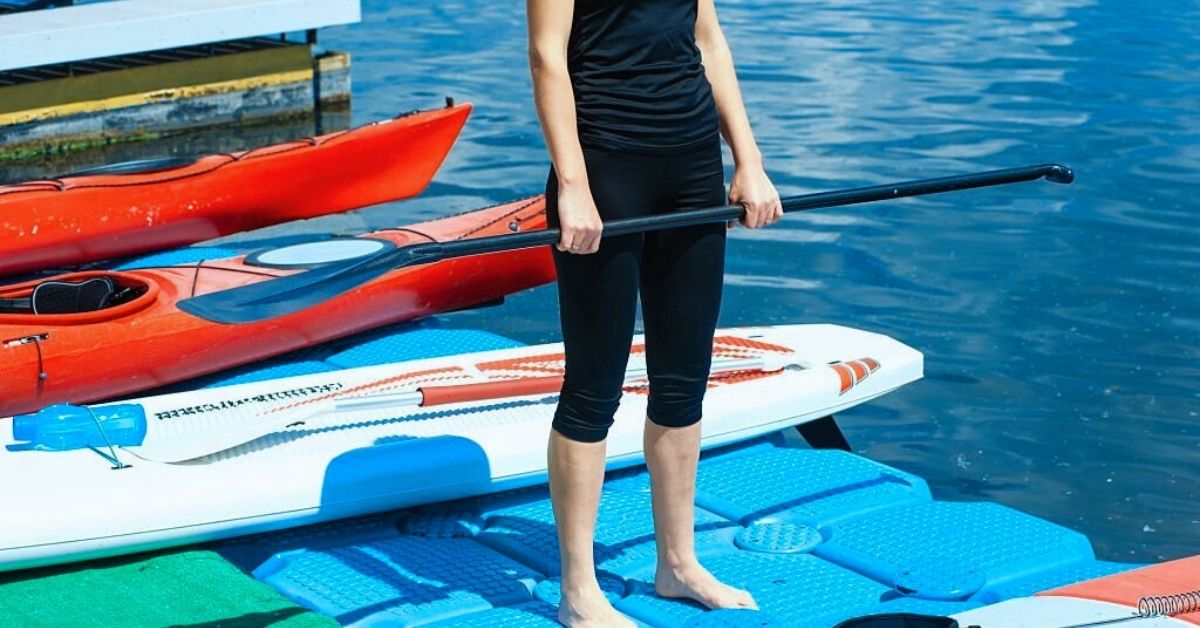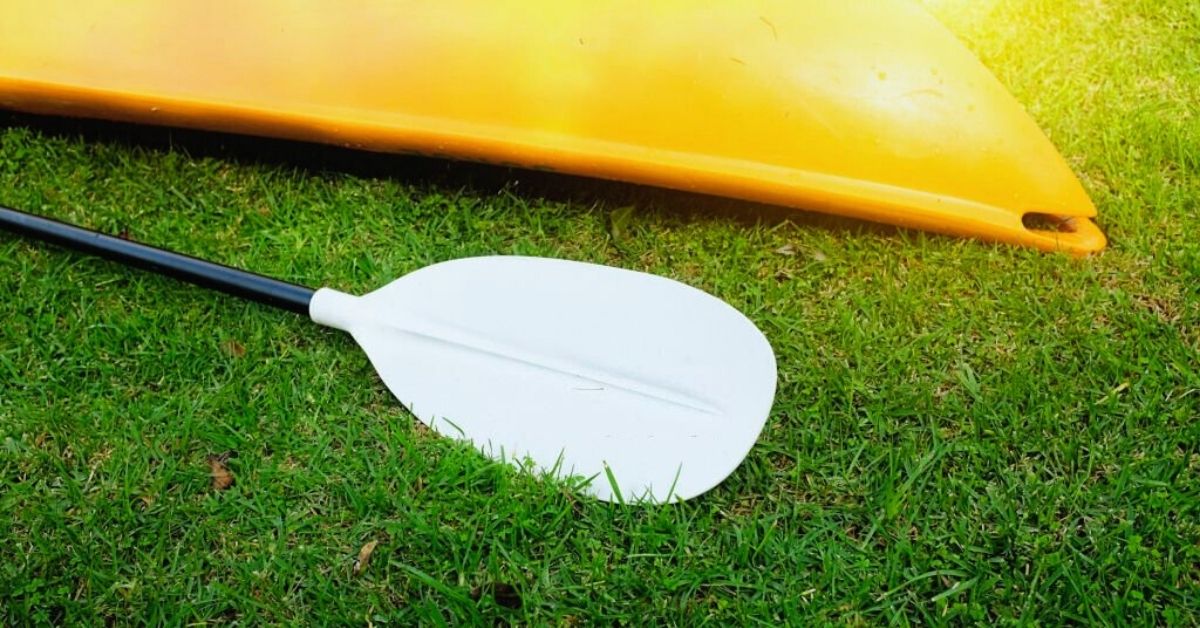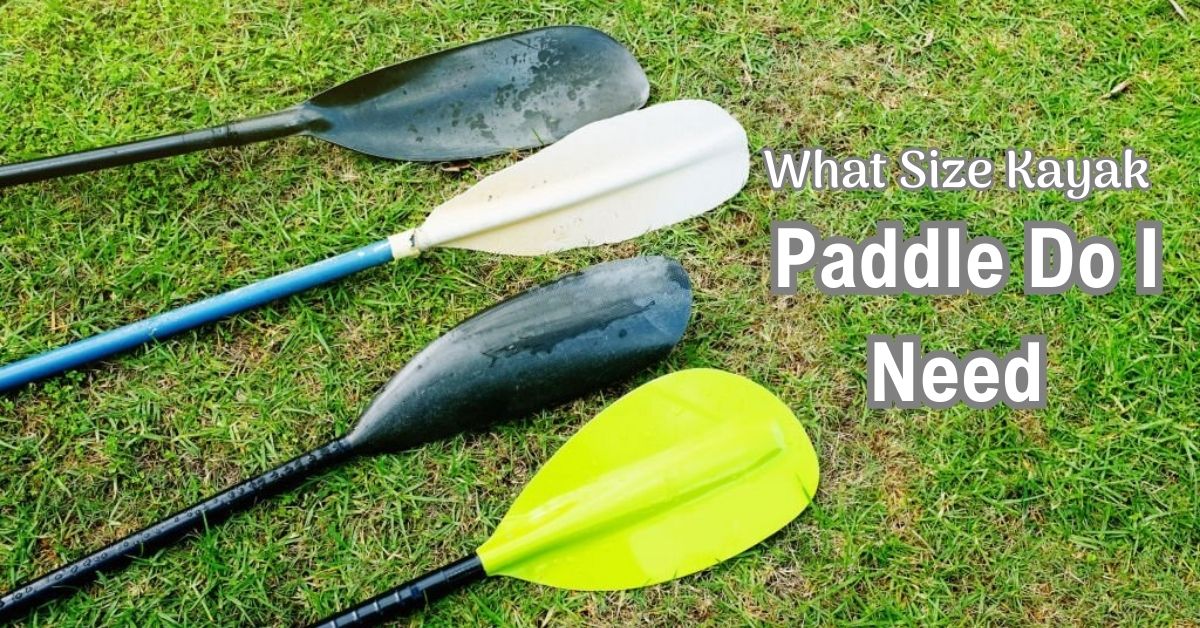Everyone may enjoy kayaking, regardless of age or fitness. However, the perfect kayak paddle may make or break your trip.
A lengthy or short paddle might produce tiredness, pain, and damage. When buying a kayak paddle, size counts. Here’s a complete guide on What Size Kayak Paddle Do I Need.
We will explain how your height, arm spread, paddling technique, and kayaking type effect paddle length. You will know how to choose the right kayak paddle size for your next water excursion after reading this page.
Table of Contents
1. Introduction
The appropriate kayak paddle is vital for a smooth, comfortable ride. Size is important when buying a kayak paddle. Choosing the right paddle size may improve your performance, comfort, and efficiency.
Finding the proper kayak paddle size for your requirements is explained in this detailed article. Whether you’re a newbie buying your first paddle or an experienced kayaker upgrading, paddle size is vital.
We’ll discuss height, kayak width, paddling technique, and personal taste when choosing paddles. The knowledge and courage to choose a kayak paddle size that fits you will maximize your paddling experience at the conclusion of this tutorial.
Choosing the proper kayak paddle size
Choosing the correct kayak paddle size is essential for comfort and efficiency. Many paddlers misjudge paddle size, causing pain, exhaustion, and injury.
Your kayak paddle size influences stroke efficiency, maneuverability, and paddling enjoyment. A lengthy or short paddle might disrupt your balance and make kayaking difficult.
Your height is important when choosing a kayak paddle size. Taller people need longer paddles, whereas shorter people need shorter ones. Long paddles affect the angle at which they enter the water and the leverage you have with each stroke.
The breadth of your kayak is another consideration. To reach the water comfortably and stroke effectively, wider kayaks need longer paddles. To avoid striking the kayak sides, narrower kayaks need shorter paddles.
Paddle shaft length matters too. A longer shaft provides for a wider grip and benefits people with larger shoulders or greater angle strokes. A shorter shaft suits folks with smaller shoulders or a lower angle stroke.
2. Knowing kayak paddle sizes
Understanding kayak paddle size is essential for pleasant and effective paddling. Choosing the proper paddle size helps improve performance and reduce fatigue and injury.
To choose the right paddle size, consider your height and kayak width. Taller people need longer paddles, whereas shorter people need shorter ones. Paddle length also depends on kayak width. Wider kayaks need longer paddles for reach.

To obtain the right paddle length, add 8-10 inches to your height. This rule may change based on your paddling technique and preferences. Some prefer a longer paddle for power, while others prefer a shorter paddle for maneuverability.
When picking a kayak paddle, blade size and design are crucial. Blade size impacts stroke power. While larger blades produce greater power but demand more work, smaller blades are easier to paddle for longer.
Blade design also affects paddle effectiveness in various water conditions. A broader, rectangular blade is stable and controlled on calm seas. However, a smaller, teardrop-shaped blade provides for a smoother, more effective stroke in rougher conditions.
Kayak paddle parts
Understanding the components of your kayak paddle is vital to picking the right size. Each part affects paddling performance and comfort.
1. Shaft Length
The shaft length is the paddle between the blade and grip. A shaft length that suits your kayak’s width and paddling technique is essential.
A longer shaft is best for broader kayaks and more relaxed paddling. Narrower kayaks and aggressive strokers benefit from shorter shafts.
2. Blade shape and size
The blade of the paddle contacts the water to propel your kayak. Blade design and size vary greatly depending on paddling technique and preferences.
For fast, powerful strokes, larger blades are better. However, smaller blades are preferable for mobility and leisure or less aggressive paddling.
3. Blade Material
Blade materials include plastic, fiberglass, carbon fiber, and wood. Each material has distinct weight, durability, and flexibility.
Carbon fiber blades are lightweight and perform well, whereas plastic blades are cheaper and more durable. Choose a blade material based on budget, paddling frequency, and performance.
4. Shape of Grip and Shaft
The paddle handle should be solid and pleasant. It should offer a natural grip, reducing wrist and arm fatigue during long paddling sessions. The shaft’s straightness or bend affects comfort and efficiency. For ergonomics, some paddlers prefer a bent shaft, while others prefer a straight shaft.
Knowing the parts of a kayak paddle might help you choose the proper size. Remember your kayak type, paddling technique, and personal preferences for a comfortable and pleasurable paddle.
3. Kayak Paddle Length Considerations
Kayaking requires the correct paddle size for comfort and efficiency. The length of your kayak paddle affects your maneuverability and rhythm.
Height is the first consideration when choosing a kayak paddle. Taller people need longer paddles, whereas shorter people need shorter ones. The paddle length impacts kayak reach and control. A short paddle might create ineffective strokes, while a lengthy paddle can strain your muscles.
The width of your kayak is also significant. Wider kayaks need longer paddles to handle the additional hand distance. This allows you to reach the water without straining your body or paddling technique. Narrower kayaks need shorter paddles for best control and agility.
Your paddle length should also depend on your paddling technique and kayaking activity. For leisurely paddling or touring, a longer paddle may be more efficient and stable. If you enjoy whitewater kayaking or confined locations, a shorter paddle may be more agile.
Finally, the ideal paddle length depends on comfort and choice. Paddlers may pick a longer paddle for a faster tempo or a shorter paddle for a slower pace. Find a paddle length that’s comfortable and natural to you to improve your kayaking experience.
Finally, consider your height, kayak width, paddling technique, and personal choice when choosing a kayak paddle length. By considering these variables, you may discover the best paddle for efficient strokes, excellent control, and fun on the water.
– Paddle length dependent on kayak width
For comfortable and effective paddling, choose the right paddle length for your kayak width. To maximize stroke power and minimize fatigue on the water, paddle length is key.
A basic rule of thumb applies to kayak width. Narrower kayaks need a shorter paddle, whereas larger ones need a longer one. A narrower kayak needs less reach to paddle effectively, whereas a broader kayak requires a longer reach to completely immerse the paddle blade.
A simple calculation can calculate the paddle length for your kayak width. Measure your kayak’s widest point and add 20 cm (8 inches). This will help you choose a kayak paddle length.
However, personal choice and paddling technique also matter. Based on their body proportions and kayaking style, some paddlers choose longer or shorter paddles. If you kayak recreationally, a shorter paddle may be more maneuverable. For endurance paddling or touring, a longer paddle may boost stroke power and efficiency.
Consider paddle shaft length when calculating kayak width. A longer paddle shaft allows a higher hand position for broader kayaks, reducing leaning and strain.
The most important thing is to pick a paddle length that lets you reach the water with each stroke and paddle naturally. Your kayak width and personal preferences might help you choose the right paddle length for kayaking.
– Considering height and paddling technique
Choosing the right kayak paddle requires evaluating your height and paddling technique. The correct paddle size improves performance and makes paddling pleasant and efficient.
Talk about height first. The right paddle length depends on your height. Taller people need longer paddles, whereas shorter people need shorter ones. This is because paddle length impacts stroke reach and power.
A simple method may estimate your appropriate paddle length depending on height. Standing upright, extend your arm over your head. 90-degree elbow bend. Get your fingers to your shoulder height. This dimension will help you choose paddle length.
Now examine your paddling style. Different paddling techniques demand different lengths. If you paddle high-angle, with your top hand over your shoulder, you need a shorter paddle. If you favor a low-angle paddling technique with your top hand at or below your shoulder, a longer paddle may be better.
Note that these are basic rules and personal choice matters. Based on comfort and skill, some people choose longer or shorter paddles.
Remember to combine comfort and efficiency while picking a paddle size. A too-long or too-short paddle may cause tiredness, pain, and damage. To choose the right paddle size for your kayaking experiences, consider your height, paddling technique, and preferences.
4. The advantages of paddle length testing
Understanding the advantages of trying different kayak paddle lengths is essential when picking the right size. Every paddler is different, and choosing the proper paddle length might improve your kayaking experience.
Trying various paddle lengths helps you discover the most comfortable and effective stroke. A brief paddle strains your shoulders and arms, causing tiredness and poor performance.
A paddle that is overly lengthy might make it difficult to maintain good technique, resulting in ineffective strokes and injuries. By exploring various paddle lengths, you might find one that fits your needs and makes paddling easy.

Testing different paddle lengths helps you identify the best one for your kayak and paddling style. varied kayak widths and designs demand varied paddle lengths for reach and control.
A broader kayak may need a longer paddle to reach the water and stay balanced. Try several paddle lengths to find the one that best suits your kayak and paddling style, increasing your performance.
Finally, using varied paddle lengths lets you adjust to water conditions and paddling activities. For touring and long-distance paddling, longer paddles give greater power and efficiency each stroke.
However, shorter paddles are better for whitewater and surfing maneuverability and acceleration. Try several paddle lengths to find the right one for your circumstances and activity, improving your paddling experience.
For choosing the perfect kayak paddle, evaluating different paddle lengths has several advantages. It helps you determine the best stroke, paddle size, and adjust to diverse water conditions and activities. So test various paddle lengths and see how they benefit your kayaking.
– Borrowing or renting paddles to try various sizes
Finding the right kayak paddle size for your physique and paddling style is crucial. You may study and read reviews, but nothing beats testing various sizes in real life.
The easiest method to try various paddle sizes is to borrow or rent them. Many kayak rental companies and outdoor equipment retailers rent paddles, letting you try different sizes before buying. This is particularly helpful for novices or those uncertain about their suitable size.
By testing various paddle sizes, you can see how they feel in the water. Focus on comfort, control, and efficiency. Does the paddle feel long or short? Does the blade size fit your paddling style? These are crucial factors that might impact your kayaking experience.
If you’re starting out or upgrading your gear, borrowing or renting paddles may save money. It lets you learn more and choose a paddle size without committing.
Remember, selecting the appropriate kayak paddle size maximizes performance and minimizes pain and damage. Take advantage of borrowing or renting paddles and try them out. It’s a smart approach to select the right size for kayaking.
5. Considerations for blade size
Choosing the right kayak paddle requires consideration of blade size. The paddle’s blade size affects your paddling pleasure, efficiency, and performance.
Blade geometry affects stroke efficiency
Blade shape affects stroke efficiency when picking a kayak paddle. The blade shape affects your paddling and water performance.
There are blade shapes for different paddling techniques and preferences. The main blade forms are symmetrical and asymmetrical.
A balanced paddle with uniform blades is adaptable and ideal for varied strokes. This blade design is perfect for recreational kayakers or novices learning to paddle. It helps maintain a steady water rhythm by providing constant force and control throughout the stroke.
Consider your paddling style, skill level, and usage when choosing a blade shape. Recreational paddlers who like leisurely outings on calm lakes or slow-moving rivers may choose symmetrical blades for their flexibility and simplicity of usage.
For fast, high-performance kayakers, an asymmetrical blade may improve your strokes and save effort. Your paddler preferences and aims will determine the best blade shape. Before choosing a blade shape, test out several ones to see how they affect your kayaking experience.
– Considerations for paddle material and weight
Different paddle materials have pros and drawbacks. Explore several typical paddle materials and how they affect kayaking.
1. Aluminium: Aluminium paddles are durable and affordable. They are popular with novice and leisure paddlers. Aluminum paddles are heavier than other materials, which may cause fatigue during extended paddles.
2. Fiberglass paddles balance weight and durability: They are lighter than aluminum paddles, making them simpler to handle and less tiring. Flexibility improves efficiency and reduces joint strain with fiberglass paddles.
3. Carbon Fiber: Lightweight and robust carbon fiber paddles. They function well and are popular with expert paddlers. Stiff carbon fiber paddles distribute power efficiently with each stroke. However, they cost more than other materials.
Paddle weight should be considered along with material. A lighter paddle reduces effort and fatigue, particularly during lengthy paddles. To guarantee the paddle can endure your kayaking experiences, balance weight and durability.
Remember, choosing the proper paddle material and weight is essential for a pleasant kayaking experience. Research and try various paddles to discover one that meets your demands and improves your water time.
– Skill level and kayak paddle purpose
When picking a kayak paddle size, consider your skill level and planned usage. The appropriate paddle size may improve kayaking comfort, efficiency, and maneuverability.
Beginners and individuals with little paddling expertise should use a shorter paddle. When crossing limited locations, a shorter paddle is simpler to handle and stroke. A shorter paddle needs less work, which is great for establishing confidence and stamina when kayaking.
Apart from skill level, kayak paddle size depends on planned usage. A shorter paddle might be adequate for relaxed paddling. A shorter paddle may be better for whitewater kayaking or kayak fishing, when mobility and control are crucial.
The appropriate paddle size depends on personal choice and body proportion. A longer paddle may help a taller person reach into the water. Conversely, a shorter paddler may find a shorter paddle easier.
Finding the proper kayak paddle size depends on your skill level, intended usage, and personal characteristics. Consult with experts or experienced paddlers for advice.
– Understanding Paddle Length and Blade Size
Finding the proper kayak paddle size is essential for comfort and efficiency. Choose your paddle size intelligently since it will considerably effect your water performance.
First, paddle length. Your kayak paddle length depends on your height and breadth. Taller people and broader boats need longer paddles. However, shorter people or narrower kayaks need shorter paddles. You can discover the right paddle length for your kayak and body type by trying various lengths.
Blade size is next. Paddling experience is also affected by paddle blade size. Large blades allow for stronger strokes, making them ideal for whitewater kayakers and experienced paddlers. Smaller blades are better for casual paddlers who value efficiency and endurance over power.
Your body type, boat width, and paddling technique determine the best kayak paddle size. Always test several paddle sizes before choosing. Many kayak rental establishments let you try out different paddle sizes to choose your favorite.
By knowing paddle length and blade size, you may pick the optimal kayak paddle to improve performance, reduce fatigue, and optimize water fun. Take time to pick the proper size and prepare for an amazing kayaking journey!
6. Perfecting your paddle choice
Finding the appropriate kayak paddle size is essential for performance and comfort. Your kayaking experience may be greatly improved by paddle selection.
– Adjusting for comfort and preference
Customizing the proper kayak paddle to your comfort and choice is essential. There are broad criteria for picking paddle sizes based on height and kayak width, but everyone’s body mechanics and paddling technique are different.
One factor is paddle length. A longer paddle with a broader stroke provides greater power but requires more work and may tire over long distances. However, a shorter paddle allows for faster and more agile strokes, making it perfect for whitewater kayaking in tight areas.
Another consideration is paddle blade size and shape. Wider blades generate greater power and are better for touring and fishing, which need efficiency and stability. However, narrower blades are lighter and quicker, making them popular for leisure paddling and racing.
Paddle material may also affect comfort and performance. For more experienced paddlers, fiberglass and carbon fiber paddles are lightweight and transmit power well. However, aluminum or plastic paddles are cheaper and more durable, making them ideal for novices and budget-conscious players.
Beyond these factors, try various paddle sizes and shapes to discover your comfort zone. Renting paddles from friends or kayak rental facilities might help you figure out what suits your physique and paddling style.
– Considering your kayaking style
Choosing the right kayak paddle size depends on your kayaking activity. Different paddles maximize performance and water experience for different sports.
A shorter, broader paddle may suit recreational kayakers on calm lakes or slow-moving rivers. This paddle has increased water surface area, making it simpler to handle. It is also less tiring, making it excellent for leisurely paddling.
For experienced sea kayakers or those who like tough seas, a longer, thinner paddle is advised. The larger paddle length enhances reach and the thinner blades minimize water resistance, making strokes more efficient.
When paddling against strong currents or in windy circumstances, this may greatly boost your speed and performance.
For kayak fishing, a customized paddle may be optimal. These paddles frequently include measuring tapes, hook retrieval notches, and tiny nets for landing fish. They provide fishermen the utility and convenience they need to concentrate on fishing while preserving control and stability.
Whitewater kayakers must use a different paddle to negotiate fast-flowing rivers and hazards. These paddles are shorter and stronger, having strengthened blades to resist pebbles and other dangers. Their strong strokes let paddlers to navigate rapids and execute difficult moves with accuracy.
7. Maintenance of your kayak paddle
Keep your kayak paddle in good condition to maximize its lifespan and performance. A few easy procedures can maintain and prolong the life of your paddle.
First, clean your paddle with fresh water after each usage, particularly if you kayaked in saltwater or muck. This will remove dirt and corrosives from the paddle. Carefully rinse the paddle’s blade, shaft, and handle using a hose or bucket.

To keep the paddle performing well, wax or coat the blade occasionally. This will reduce scratches, increase water resistance, and strengthen the paddle. Follow the manufacturer’s recommendations and use a kayak paddle maintenance product.
Maintaining your paddle’s condition requires proper storage. Keep it dry, aired, and out of direct sunlight and excessive temperatures. Not leaning or piling heavy things on the paddle might bend or deform it.
– Proper storage and cleaning
Proper storage and cleaning are vital for kayak paddle durability and performance. Maintaining your paddle will lengthen its lifetime and improve its performance. Consider these crucial tips:
• The paddle should be completely dried before storage after each usage. This prevents mould and mildew from deteriorating the paddle. Remove moisture from the shaft and blades using a cloth.
• Choose a dry, well-ventilated storage place. Avoid severe temperatures and humidity, which might harm the paddle. To avoid warping, keep the paddle horizontally or on a paddle rack.
• Protect the Blades: Store paddle blades in blade coverings or soft cloths to avoid scratches and damage. This will help avoid inadvertent damage during shipment or storage with other equipment.
• Avoid direct sunlight: Prolonged exposure might degrade the paddle’s materials. To preserve your paddle from the sun, keep it in the shade or use a UV-resistant cover.
• Regular Cleaning: Rinse your paddle with fresh water after each usage, particularly if you paddled in sea or dirt. Remove dirt and grime with gentle soap or paddle cleaning. Rinse off all soap to prevent residue that might hinder paddle function.
• Check for Damage: Check your paddle for cracks, splits, and loose components often. Address any faults immediately to avoid additional damage and preserve paddling safety.
These storing and cleaning methods can keep your kayak paddle in top shape, letting you enjoy many water excursions.
– Proper Kayak Paddle Sizing Considerations
Kayaking with the appropriate paddle size may change your experience. How do you pick the right kayak paddle size? Discover the elements you should examine to discover the appropriate match.
1. Paddle Length:
Paddling efficiently and comfortably requires paddle length. A lengthy paddle might strain your muscles and make it hard to steer your kayak, while a short paddle may not create enough force with each stroke. Consider your height, kayak width, and paddling technique when choosing a paddle length.
2. Length and Diameter of Shaft:
The shaft length and diameter also affect paddle fit. The shaft should be long enough for comfortable hand positions but not too lengthy to wield. For a comfortable, ergonomic grip, the shaft diameter should fit your hands.
3. Blade shape and size:
The paddle blade form and size effect stroke efficiency and maneuverability. A greater blade size generates more power with each stroke, making it appropriate for stronger paddlers or those in difficult circumstances. For leisure paddling or smaller people, a lower blade size provides greater control.
4. Materials and Weight:
Material and weight of the paddle might affect your paddling experience. Fiberglass, carbon fiber, and aluminum are common paddle materials.
Each material has price, weight, and durability benefits and downsides. Choose a material according on your paddling style, frequency, and budget.
5. Preference: Personal
Personal choice determines the best kayak paddle size. Your strength, experience, and planned application should be evaluated. Try several paddle sizes and types to find the most comfortable and efficient one.
By carefully examining these aspects, you may pick the right kayak paddle size to improve your performance and pleasure on the water. Remember, the appropriate fit is vital for easy paddling. Take your time, investigate, and choose your kayak paddle wisely. Happy paddling!
8. Conclusion
In conclusion, a comfortable and efficient kayak paddle requires the right size. By considering your height, paddling style, and kayaking style, you may choose a paddle that improves your performance.
Following these rules and choosing the right kayak paddle size will prepare you for your kayaking trips and make paddling more fun and efficient. So take your paddle and confidently kayak your next adventure!
